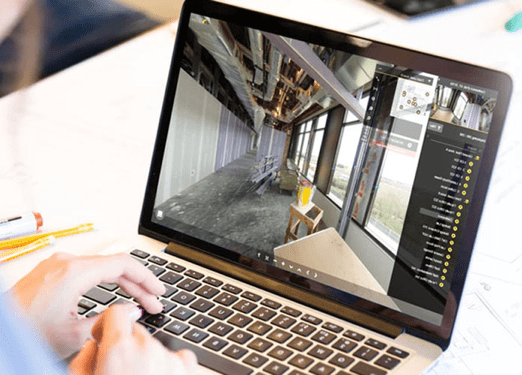Virtual Inspections are Speeding Generator Installations in Half the Time
Anthony Perera
The U.S. is facing a growing power crisis. Millions of Texans were left without power for weeks during the severe winter storms of February 2021. Fears of summer blackouts across the western U.S. were amplified by droughts and extreme heat. Hurricane Ida left another 1 million people throughout Louisiana, New York, and New Jersey without power in October 2021. The U.S. Energy Information Administration reports that U.S. electricity customers experienced more than eight hours of power interruption, on average, in 2020.
An aging power grid system and volatile weather leave concerned homeowners desperate to avoid being left in the dark. As a result, demand for residential back-up generators is surging. But generator installation companies across the country face a daunting task: meeting the growing demand while lacking enough time and labor to speed up the process.
Brian Inouye, installation manager at Generator Supercenter in Fort Myers, Fla., says customers may wait 20 to 40 weeks to get generators installed. Supply disruptions and labor shortages are only parts of the problem, he adds.
Challenges of Traditional Inspections
The generator installation process can be lengthy, and as many as six code inspections are required from start to finish. City and county inspection departments, chronically short-staffed due to the lack of experienced tradespeople able to become inspectors, also must deal with inspectors’ lengthy drive times between job sites, high demand for inspection services during the current building boom, and the challenges of safely doing in-person inspections during a pandemic. All those factors add up to long waits at job sites, costing installers time and money.
“The current inspection and permitting process needs improvements in nearly every way. It’s expensive, time-consuming, and stalls our work by causing additional setbacks,” Inouye says. “We would be wasting someone’s entire day waiting around to just get an inspection completed when they could have been helping a customer or supporting our team elsewhere.”
When Generator Supercenter relied on traditional in-person code inspections, a generator installation would take one to 1½ months to complete due to the shortage of inspectors and inspectors’ limited availability. Depending on the municipality, an inspector would be available only from 8 a.m. to 4 p.m. or would require scheduling seven days in advance.
Needing to complete multiple inspections efficiently and within certain time frames, Generator Supercenter sought a solution that could be flexible with scheduling, could help manage projects, and was certified in the counties the company serves. The company turned to an emerging technology with Inspected.com that offers access to a deep roster of certified inspectors who can ensure code compliance through virtual, third-party provider services. The remote inspections advance the permitting process without stretching the installer’s resources thin or sacrificing quality and customers’ trust.
Since Generator Supercenter began using the virtual inspection service in September 2021, its installation time has been slashed in half. Jobs now are completed in an average of 14 days.

Benefits of Virtual Inspections
Third-party, virtual inspections can reduce costs, save time, maximize resources, increase productivity, and benefit customers by eliminating the time spent waiting for a government code inspector.
Inspection platforms developed with contractors in mind allow to contractors to create a profile for each project online, geo-tag it to verify the address, and open a permit request. inspectors then can review the installer’s plans and the government-required documentation. Contractors can schedule an inspection, say of a natural gas tank or of electrical connections, for a specific day and message the inspector whenever the crew is ready. An inspector working remotely then joins the call and uses the inspection software to go through the checklist of code requirements, ask questions, and take high-quality video and images of the installation in progress. If an inspector finds a “small fail” that requires a 10-minute fix, the contractor can make the repair, call the inspector back, show the work, and have it pass. If an inspector finds a bigger “fail,” the installer can schedule a reinspection for the appropriate day.
Once the project has passed all its inspections, the inspector can approve the permit. The inspection platform creates a record of all the documents, which are time-stamped and GPS-verified. It also gives contractors the ability to document each step of the process and archive the video and images for use in training or sales presentations.
By being able to move the inspection process forward at the installer’s convenience, Inouye estimates that his company saves more than 100 hours of labor a month by eliminating the time crews spend waiting for inspectors and by being able to schedule inspections on short notice if crews finish ahead of schedule. Other advantages include a decrease in re-inspections and reduced liability for his contractors, he says.
Virtual inspections also give homeowners peace of mind and increase customer satisfaction. Before, because of the complicated scheduling and tight availability of in-person inspections, a generator installer would make multiple calls to homeowners who wanted or needed to be included in the inspections. Now, the company asks what time works best for homeowners instead of telling them when an inspector might arrive.
“From a customer standpoint, it makes all the difference when we can get a generator installed and operating quickly and efficiently,” Inouye says. “My team has also been able to gain a competitive edge in our market against competitors who are not utilizing virtual inspections to finalize their permits faster and streamline dated systems in their project management.”

A Bright Outlook
Many industries turned to remote, virtual solutions like Zoom when the pandemic first hit, expecting remote solutions would be a temporary way to adapt to the challenges of the pandemic. States across the country also took immediate initiative by allowing third-party, virtual inspections. For example, in July 2021, Florida lawmakers approved third-party inspections to use emerging technologies and protect the health and safety of municipal code officials, contractors, employees, and property owners.
To address concerns about contractors’ partnerships with third-party inspectors, the Florida law requires such inspectors to have attained certification by the non-profit International Code Council, the same certification required of government inspectors. The law also provides for checks and balances on the process by giving cities the power to audit up to four third-party inspections per month.
Despite the recent loosening of social distancing practices and the return to in-person work, virtual inspections continue to be used by industries including construction, utilities, and installations of solar and other alternative power sources. As more states, including Louisiana and Texas, pass laws embracing virtual inspections, these inspections are becoming a permanent solution that helps businesses save time, money, and labor and allows them to quickly move on to their next projects.
—Anthony Perera is the founder of Inspected.com, a provider of virtual inspection software based in Plantation, Fla.